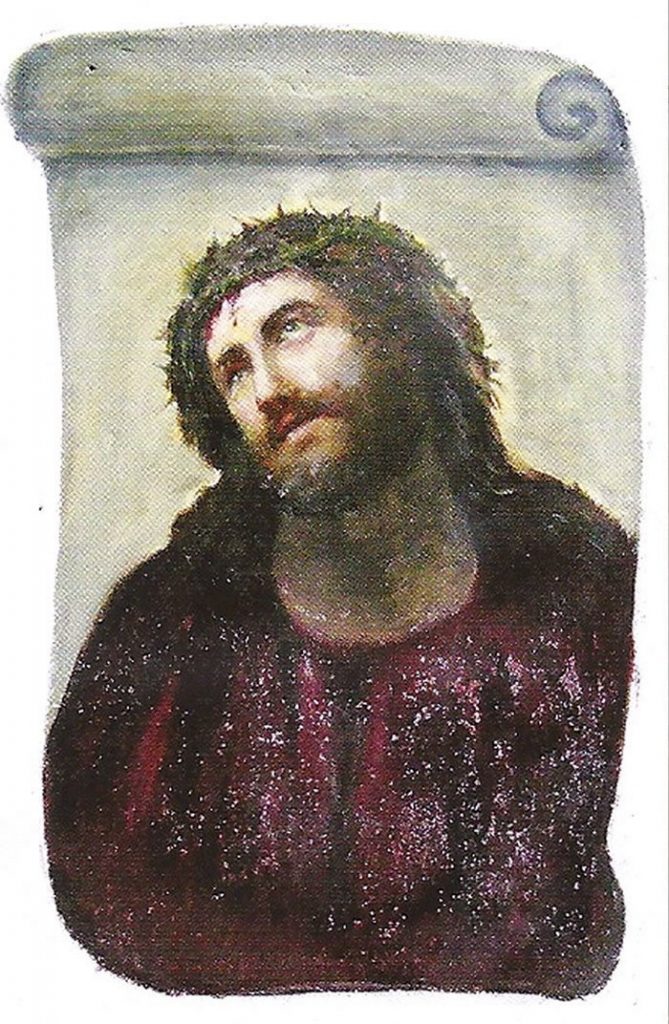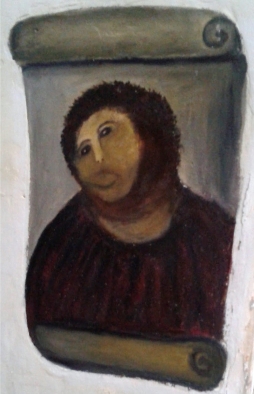When Jesus Turned into a Potato (Accidentally)
If you visited the Sanctuary of Mercy church in Borja, Spain before 2012, you would have seen the fresco, below, painted on its walls. Titled “Ecce Homo” (or “Behold the Man”), it’s a depiction of Jesus wearing a crown of thorns. Originally painted in 1930, it was generally thought of as unspectacular — a nice painting, but it’d hardly make you mistake the Sanctuary of Mercy for the Sistine Chapel. And it didn’t age well. Like all other frescos, Ecce Homo faded over time and required some restoration. Here’s what it looked like before its final restoration — again, before 2012.

Restoration, though, wasn’t in the budget — or, more accurately, a professional restoration wasn’t. Instead, that role fell to a volunteer, 80-something-year-old parishioner Cecilia Giménez. Giménez took it upon herself to touch up the fresco, aiming to bring it back to its original glory.
The good news: Giménez succeeded in transforming this uninteresting piece of artwork into something spectacular. The bad news? This is what she ended up with:

Local press picked up the story. News and pictures of the botched restoration quickly spread through the Internet, giving Ecce Homo its first taste of fame (for all the wrong reasons, though). Dubbed “Potato Jesus” because of the subject’s newfound resemblance to a tuber, the painting became a meme, inspiring many photoshopped parodies. (Here’s one of The Last Supper.)
And with that attention came visitors — thousands of visitors.
As the New York Times reported, within a few years, as many of 150,000 tourists came to Borja — a town of only about 5,000 people itself — to see the painting. This breathed new life into the sleepy town’s economy. The church began selling all sorts of gifts — pens, mugs, etc. — with the now-famous painting on it. Local vineyards began bidding for the rights to use Potato Jesus on their bottles. And to commemorate this backward miracle, a team of composers created a tongue-in-cheek opera about Borja’s unlikely redemption.
So in the end, Ecce Homo wasn’t really destroyed — it was turned into something greater than its original painter ever imagined. Giménez came out ahead, too; she gets 49% of the proceeds from souvenir sales, which she uses to fund the care for her adult son with cerebral palsy. In the end, everyone won. (But it still looks like a potato.)
Bonus fact: If you really wanted to add potatoes and Internet fame to create a small fortune, you should have done what Zack Danger Brown (as he called himself — Danger probably isn’t his middle name) did in July of 2014. Likely as a joke, Brown created a Kickstarter to fund the creation of some potato salad. Yes, that’s right, he asked people to send him money so he could make himself a side dish. And people responded. His goal was to raise $10. He topped that, and by a lot: Brown raised $55,000 (!!) from nearly 7,000 donors over the course of his month-long campaign. (Brown used the surplus money to throw a potato-themed party.)
From the Archives: A Mushroom Grows in Moscow: Jesus wasn’t a potato, but was Lenin a mushroom?
